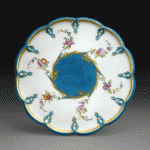Madame de Pompadour, mistress of Louis XV, had a serious passion for porcelain. She took a leading role in patronage and artistic influence at the French manufactory at Vincennes, which produced the finest objects in the realm in the 1750s. The king provided the economic support to ensure that Pompadour and his court could overindulge in these luxuries. He purchased the manufactory, restricted the movement of workers, and entrusted direction to the head chemist at the Académie des Sciences, Jean Hellot. In return, the manufactory lavished the monarch and mistress with exquisite wares designed in their honor.
One innovation that charmed the court hailed from Europe’s leading porcelain manufactory at Meissen in Saxony. Meissen’s chemists had perfected a new form in porcelain—the plate—and hatched the novel idea of an entire service of cups, plates, and servers painted with the same pattern. Louis XV asked Vincennes to copy the new form and produce the first French dinner service. For the occasion, Hellot, who was a specialist in paint, experimented with a color never before seen on porcelain wares. He wanted an underglaze rich enough to cover a whole area of the vessel—color had formerly been too thin to coat a large area well and was reserved for small designs or trim. “Celestial blue” (bleu céleste) formed a bright heavenly orb in the center of the plate and proved worthy of special presentation.
Anecdote has it that one evening in February, 1755 the service sat waiting in boxes around the royal dining room. The king planned to unveil it ceremoniously by involving guests in the ritual. He gathered the nobility before the group of crates. Everyone in attendance was asked to open one and unwrap a celestial “masterpiece.” This spectacle of the marvelous dinner plate nicely captures the excitement around the art of the table when the full porcelain service first became the must of the fashionable dinner party.
Christine A. Jones teaches French 17th/18th-century literature and culture at the University of Utah. She writes on fairy tales, porcelain, dance, and, most recently, wine.

